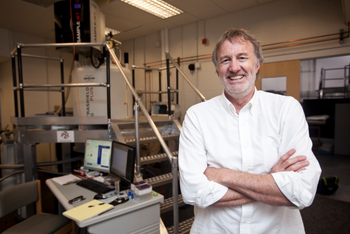Discovery of new enzyme could yield better plants for biofuel

The presence of lignin in secondary plant cell walls can be visualized using specific dyes. On this cross section of an Arabidopsis stem, the lignin has been stained red.
Photo: Wout Boerjan, VIB, Belgium
For nearly a decade, scientists have thought that they understood how plants produce lignin — a compound that gives plant tissues their structure and sturdiness, but can limit their use as a source of biofuels.
Now, thanks to a collaboration involving the U.S. Department of Energy Great Lakes Bioenergy Research Center (GLBRC) and several international institutions, researchers have identified a new gene responsible for producing a previously unknown enzyme that is central to lignin synthesis. The breakthrough, which was recently published in Science, could improve the conversion of cellulosic — or nonfood — biomass to biofuels.
“This is the first new gene in the [lignin] pathway that’s been discovered in ten years,” says John Ralph, a professor in the UW–Madison departments of biochemistry and biological systems engineering and the leader of the GLBRC Plants Research Area.
“Any time you find a new gene, you not only better understand the biochemical pathways in which the gene is involved; you also discover new ways of perturbing those pathways,” Ralph says.

GLBRC Plants Leader John Ralph poses in front of a nuclear magnetic resonance (NMR) machine in the Wisconsin Energy Institute building.
Photo: Matthew Wisniewski, GLBRC
One might assume that a single gene could have only a minor impact on overall plant development; however, it turns out that the newly discovered gene and the enzyme it produces — caffeoyl shikimate esterase, or CSE — play a crucial role in lignin formation.
In fact, when collaborating plant scientists at VIB/Ghent University in Belgium grew mutant Arabidopsis plants that had the gene in question “knocked out,” the amount of lignin in the plants’ stems was reduced by fully 36 percent. Furthermore, the lignin that did remain was quite chemically different from the lignin of a normal plant.
At UW–Madison, Ralph and GLBRC Associate Scientist Hoon Kim examined the mutant plants using cutting-edge nuclear magnetic resonance (NMR) technology housed in the Wisconsin Energy Institute building to understand the precise impact of the CSE gene on lignin development, and to explore what that could mean for biofuel production.
Because lignin plays such an important role in biomass growth and development, breaking it apart to access the simple sugars stored within plant tissues is a difficult task that often requires a combination of heat and harsh chemicals.
Knocking out the gene responsible for CSE, however, made it significantly easier to deconstruct the mutant plants because their lignin was less abundant, and their cell walls were more digestible. This suggests that reducing and altering lignin content and structure by targeting CSE could lower the time, energy and cost of processing cellulosic biomass into fuels.
“In principle, this discovery should make biofuel processing faster and cheaper for industry.”
John Ralph
“In principle, this discovery should make biofuel processing faster and cheaper for industry,” says Ralph.
Plants research at the GLBRC focuses on answering basic science questions about plant cell wall structure in order to develop new technologies that will form the basis for advanced cellulosic biofuel production.
“We benefit from having John Ralph — a world-class lignin expert — and his innovative research group at the GLBRC,” says Director Tim Donohue, a UW–Madison professor of bacteriology. “The discovery of CSE has the potential to make game-changing improvements in biomass processing and conversion strategies.”
In addition to GLBRC and VIB/Ghent University, the international project involved researchers from the James Hutton Institute and University of Dundee in Scotland. The work was jointly funded by Ghent University, GLBRC, and Stanford University.
For the scientific community, the discovery of CSE and the gene that controls it will forever change how lignin production in plants is understood. For Ralph and his colleagues at the GLBRC, another major benefit of this work is the opportunity to create another route to commercial-scale cellulosic ethanol production.
“In the past, the wrong substrates and products were assumed to be involved in several steps of lignin biosynthesis, but now the pathway is becoming more completely understood,” says Ralph. “In addition, this and other discoveries are providing bioenergy researchers in particular with new approaches that have significant potential for improving biofuel processing.”
—Celia Luterbacher
Tags: biosciences, energy, research



